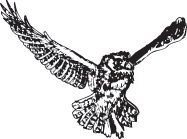

Hawks of New York State
| Species | Habitat | Diet | Nest | Eggs | Hunting Technique | General Information |
| Northern Harrier | open fields and marshes | voles, snakes, frogs, insects, carrion | sticks, grass on elevated ground | 5 bluish-white, usually unmarked | cruising flights over open grassland | high nest predation long wings, long tail, low cruising flights |
| Sharp-shinned Hawk | young woodland | birds, rarely rodents, frogs, insects | stick nest lined with evergreens | 4-5 white marked with browns | perches on tree branches, then dashes after prey |
our smallest accipiter, short, rounded wings and long tail |
| Cooper's Hawk | woodland | mostly birds and small mammals | stick nest lined with evergreens | 4-5 bluish-white spotted with browns | low dash through woods | short rounded wing and long tail, often perches on fence posts, "chicken hawk" |
| Northern Goshawk | mature woodlands | mostly ground birds, some small mammals | stick nest lined with evergreens | 3-4 bluish-white | low patrols in woodlands | fairly pointed wings and long broad tail, the largest of our accipiters |
| Red-shouldered Hawk | wooded streams and swamps | rodents, snakes, lizards, insects, birds | stick nest with green leaves | 3 white with brown spots, asynchronous* | soaring and "sit and wait" hunting style |
broad wing and tail shape with "fingertips" on wings, |
| Broad-winged Hawk | open woodlands | rodents, snakes, insects, young birds | sticks, twigs, dead leaves, and green leaves | 2-3 white with brown spots, asynchronous* | "sit and wait" and then swoops | winters in Central and South America, form large kettles |
| Red-tailed Hawk | edges of forest and meadows | rodents, reptiles, birds, insects, carrion | sticks, twigs, lining bark and green leaves | 2-3 white, or brown spotted, asynchronous* | soaring and "sit and wait" hunting style | first year lacks red tail and it usually migrates below snow belt |
| Rough-legged Hawk | tundra and open coniferous forest | rodents, insects, birds and carrion | sticks, grass in trees or steep banks | 2-7 greenish white, asynchronous* | swoops often at dusk, hovers and drops on prey | nomatic migrator that often winters in southern Canada and northern U.S., light and dark morph |
| American Kestrel | farmland and open fields | small birds, insects, and rodents | cavity nester, little lining material | 4-5 white, marked with brown | "sit and wait" and then swoops, sometimes hovers over prey | smallest North American falcon, tail square, long swept-back, pointed wings |
| Peregrine Falcon | open areas, rock cliffs and tall buildings | doves, pigeons, waterfowl, and songbirds | rounded scrape on high ledge | 3-4 white/pinkish-cream | swoops fast (200+ mph) and low after birds | endangered species, eggshell thinning (DDT), reintroduction in cities |
*asynchronous = asynchronously, young hatch over an extended period of several days.